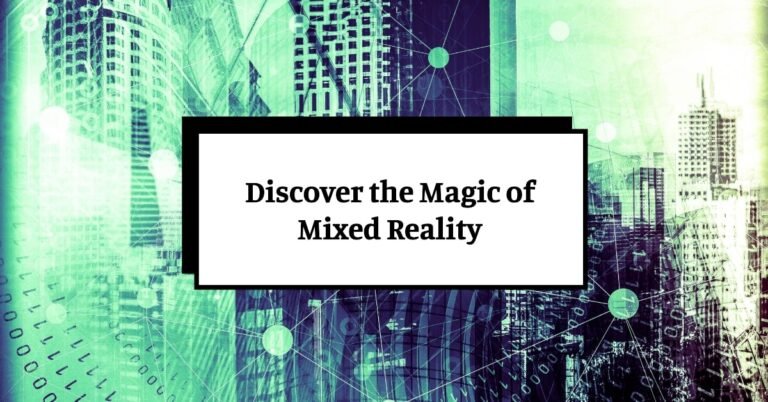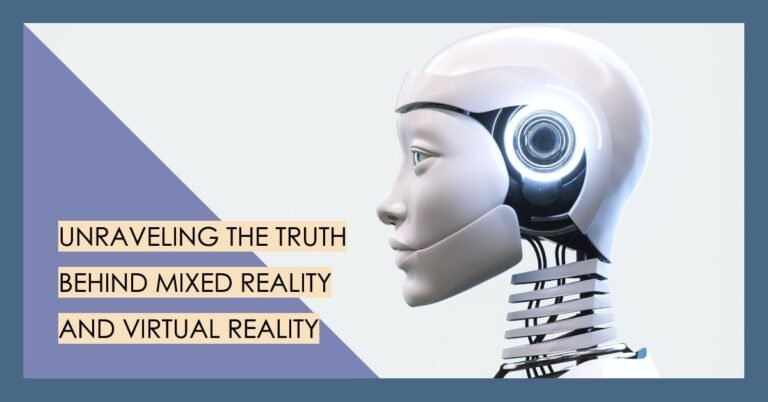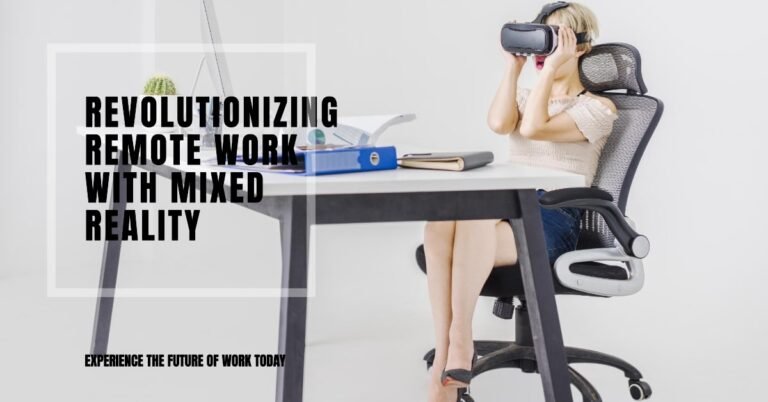What Is A Key Feature Of Mixed Reality: Real-time Interaction
What Is A Key Feature Of Mixed Reality? Imagine a world where the physical and digital seamlessly blend, creating a whole new interactive experience. That’s the power of mixed reality (MR)! But what truly sets MR apart? What Is A Key Feature Of Mixed Reality?
The answer lies in its most captivating feature – real-time interaction.
This isn’t just about passively viewing digital elements superimposed on your surroundings. In MR, you can manipulate, navigate, and alter these virtual objects as if they were part of the real world – and all this happens instantaneously!
This groundbreaking capability unlocks a treasure trove of possibilities, transforming industries, enhancing learning, and even redefining entertainment. So, buckle up, and let’s delve into the fascinating world of real-time interaction in mixed reality!
What Is The Key Feature Of Mixed Reality?
The key feature of mixed reality (MR) is its ability to blend the physical and digital worlds, creating a hybrid environment where real and virtual objects can interact in real time. Unlike augmented reality (AR), which overlays digital information onto the real world, or virtual reality (VR), which immerses users entirely in a virtual environment, MR seamlessly integrates both. This allows for more dynamic and interactive experiences, where digital elements are not just superimposed but can respond to and interact with the physical surroundings and objects.
Key aspects of MR include:
- Real-Time Interaction: Users can interact with both real and virtual elements simultaneously. For example, a virtual object can be manipulated by hand movements in the physical space.
- Spatial Awareness: MR systems use advanced sensors and spatial mapping to understand the physical environment, allowing virtual elements to interact with real-world surfaces and objects accurately.
- Immersive Experiences: MR provides a more immersive experience than AR by allowing virtual objects to exist and interact within the user’s real environment, enhancing the sense of presence and engagement.
- Enhanced Collaboration: MR enables multiple users to collaborate in the same physical space with shared virtual elements, making it useful for team-based projects and remote collaboration.
- Versatility: MR applications can be used in various fields, including education, healthcare, engineering, entertainment, and more, providing versatile solutions for training, simulation, design, and visualization.
These features make mixed reality a powerful tool for creating immersive, interactive, and collaborative experiences that bridge the gap between the real and digital worlds.
What is Real-Time Interaction in Mixed Reality?
Real-time interaction is the cornerstone of mixed reality. It allows users to seamlessly interact with both physical and virtual objects within the same environment. This interaction happens with minimal latency, creating a sense of immersion and responsiveness that’s unparalleled.
Here’s how it works:
- Advanced Sensors: MR headsets are equipped with sophisticated sensors like cameras, depth sensors, and accelerometers. These sensors track your movements and the physical environment in real-time.
- Spatial Mapping: The captured data is used to create a precise 3D map of your surroundings. This map serves as the foundation for seamlessly integrating virtual objects into the real world.
- Hand and Object Tracking: MR systems can track your hand movements and the position of physical objects you hold. This allows for intuitive manipulation of virtual objects using gestures and physical interactions.
The result? A truly interactive experience where virtual objects respond to your actions in real-time. You can pick up a virtual wrench and tighten a bolt on a 3D engine simulation, or manipulate virtual furniture to see how it looks in your living room – all within the same space!
Real-World Examples of Real-Time Interaction in MR
Let’s see how real-time interaction is revolutionizing various fields:
- Design and Manufacturing: Architects can use MR to visualize building plans within the actual construction site, allowing for real-time adjustments and collaboration with remote engineers. Imagine walking through a virtual model of a building, checking for potential design flaws and making changes on the fly. This streamlines the design process and reduces costly errors.
- Education and Training: Imagine learning complex medical procedures by manipulating virtual organs in a simulated surgery environment. MR can create immersive learning experiences that boost knowledge retention and enhance practical skills development. Trainee surgeons can practice delicate procedures on virtual patients in a safe, controlled environment before operating on real ones.
- Maintenance and Repair: Technicians can use MR to access step-by-step repair instructions overlaid on real equipment. This allows them to see exactly what needs to be done, even for complex machinery. No more flipping through bulky manuals – real-time interaction provides instant access to the information they need, improving repair efficiency and reducing downtime.
- Retail and Shopping: Furniture stores can leverage MR to allow customers to virtually place furniture pieces in their homes to see how they fit and look before purchasing. This personalized shopping experience can significantly boost customer satisfaction and sales. Imagine trying out a new couch in your living room without leaving the store – all thanks to the magic of real-time interaction in MR!
These are just a few examples, and the possibilities are truly endless. Imagine a world where firefighters can practice navigating burning buildings in a safe, simulated environment using MR. Real estate agents can showcase virtual tours of properties to potential buyers from anywhere in the world. The applications for this technology are constantly expanding, and real-time interaction is the driving force behind it all.
How Real-Time Interaction Benefits You
Whether you’re a designer, an engineer, a student, or simply someone looking for a more engaging way to interact with the world, real-time interaction in MR offers a multitude of benefits:
- Enhanced Learning: MR fosters a deeper understanding of complex concepts by allowing for interactive exploration and hands-on manipulation of virtual objects. Imagine a student of history being able to walk through a virtual recreation of a historical battleground, interacting with 3D models of soldiers and equipment. This type of immersive learning experience can significantly improve knowledge retention and engagement.
- Improved Efficiency: Real-time interaction streamlines processes in various fields, from design and manufacturing to maintenance and repair. By allowing for faster access to information and intuitive manipulation of virtual objects, MR can significantly reduce errors and improve overall efficiency.
- Increased Collaboration: MR facilitates seamless collaboration between individuals in different locations by enabling them to interact with the same virtual environment simultaneously. Imagine an architect in New York and an engineer in London working together on a building design in real-time using MR. They can both manipulate the virtual model, discuss changes, and make edits collaboratively, regardless of the physical distance. This fosters better communication, streamlines workflows, and boosts overall project efficiency.
- Boosted Engagement: Real-time interaction creates a more engaging and interactive experience, making learning and work more enjoyable and motivating. Imagine a trainee mechanic learning how to disassemble and reassemble an engine in an MR environment. They can manipulate virtual components, see how they fit together, and troubleshoot potential problems – all in a safe, interactive setting. This type of hands-on learning experience is far more engaging than traditional methods, leading to better knowledge retention and improved skill development.
Beyond these core benefits, real-time interaction in MR opens doors to exciting new possibilities:
- Personalized Experiences: Real-time interaction allows for user customization within MR environments. Imagine an athlete using MR to personalize their training routine. They can project virtual training partners or opponents, adjust difficulty levels on the fly, and receive real-time feedback on their performance – all within a dynamic MR environment.
- Entertainment Revolution: The gaming industry is poised to be transformed by real-time interaction in MR. Imagine exploring vast virtual worlds, interacting with characters, and manipulating objects – all with the feeling of being physically present in the game. This level of immersion will redefine the gaming experience, blurring the lines between reality and the virtual world.
- Accessibility Enhancements: Real-time interaction in MR has the potential to revolutionize accessibility for people with disabilities. Imagine someone with limited mobility being able to virtually explore new places or participate in activities that would be physically challenging in the real world. MR can create a more inclusive and accessible environment for everyone.
Examples of How the Key Feature Works in Action
Here are some examples that illustrate how the key feature of mixed reality (MR) works in action, showcasing its ability to blend virtual and real-world elements:
Design and Visualization:
- Scenario: An architect using MR goggles designs a building in a real-world environment like an empty lot.
- How it works: The architect can see 3D models of the building overlaid on the actual site. They can adjust the design in real-time, seeing how it fits with the surroundings and how natural light interacts with the structure.
Maintenance and Repair:
- Scenario: A technician is repairing a complex machine in a factory.
- How it works: Through MR glasses, the technician sees virtual overlays of technical manuals, schematics, and step-by-step instructions directly on the machine parts. They can interact with these virtual guides, such as highlighting components to be inspected or replaced, without constantly referring to physical manuals or screens.
Education and Training:
- Scenario: Medical students learning about human anatomy.
- How it works: Using MR headsets, students can see realistic 3D holograms of organs and body systems superimposed on physical models or even on real patients (in a controlled medical setting). They can interact with these holograms to understand complex structures and functions better.
Virtual Collaboration:
- Scenario: Designers from different locations working on a car prototype.
- How it works: Each designer wears MR headsets and sees a virtual car model overlaid on a physical car chassis. They can manipulate the virtual model collaboratively in real-time, making adjustments and discussing design changes as if they were physically present together.
Retail and Marketing:
- Scenario: A customer shopping for furniture.
- How it works: Using an AR-enabled app or MR glasses in a store, the customer can visualize how different furniture pieces would look in their home. They can see virtual furniture overlaid on their real living space through the device, adjusting sizes and colors before making a purchase decision.
Entertainment and Gaming:
- Scenario: A group of friends playing a multiplayer game in a park.
- How it works: Each player wears MR glasses and sees virtual game elements (characters, obstacles, rewards) integrated into the park environment. They can physically move around the park while interacting with these virtual elements, enhancing the gaming experience with real-world interactions.
Benefits of the Key Feature
The key feature of mixed reality (MR), which involves seamlessly blending virtual and real-world elements, offers several significant benefits across various fields and applications:
Enhanced User Experience:
MR provides a more immersive and engaging experience compared to traditional interfaces. Users can interact with virtual objects in their physical environment, making experiences more intuitive and natural.
Improved Visualization and Understanding:
MR allows complex data, designs, and concepts to be visualized in 3D and overlaid onto real-world objects. This improves comprehension and decision-making processes, especially in fields like education, engineering, and medicine.
Increased Efficiency and Productivity:
In industries such as manufacturing, maintenance, and construction, MR enables workers to access real-time information and instructions overlaid onto physical equipment. This reduces errors, speeds up processes, and enhances overall productivity.
Collaboration and Communication:
MR facilitates collaborative work environments where teams can interact with virtual models and simulations in real time. This is particularly beneficial for remote collaboration, training sessions, and design reviews across different locations.
Personalized Experiences:
MR can tailor experiences based on individual preferences and needs. For example, in retail, customers can visualize products in their own space before purchasing, enhancing satisfaction and reducing returns.
Innovation and Creativity:
MR fosters innovation by enabling the creation of new types of applications and experiences that blend digital and physical elements creatively. This encourages experimentation and the development of novel solutions across industries.
Real-World Integration:
Unlike purely virtual environments (e.g., VR), MR maintains awareness of the physical surroundings. This integration allows for applications that respond dynamically to changes in the real world, enhancing adaptability and usefulness.
Training and Simulation:
MR is highly effective for training scenarios where hands-on experience with virtual objects in real-world contexts is crucial. This is valuable in fields such as healthcare (e.g., surgical simulations) and aviation (e.g., pilot training).
Cost Savings and Risk Reduction:
By simulating scenarios in a mixed reality environment, organizations can mitigate risks and reduce costs associated with physical prototypes, testing, and training. This leads to more efficient processes and improved safety measures.
Overall, the key feature of mixed reality offers transformative benefits by bridging the gap between virtual and real-world experiences, enhancing interactions, productivity, and creativity across various sectors.
The Future of Real-Time Interaction in Mixed Reality
The potential of real-time interaction in MR is vast and continues to expand rapidly. Here’s a glimpse into what the future holds:
- Advanced Haptics: The integration of haptic technology will allow users to not only see and interact with virtual objects but also feel their texture and weight, creating an even more realistic experience. Imagine manipulating a virtual object in an MR environment and feeling its weight and resistance, just like you would with a real object. This will significantly enhance the sense of immersion and realism in MR experiences.
- Enhanced AI Integration: Artificial intelligence will play a crucial role in personalizing MR experiences and making real-time interaction more intuitive and natural. AI can analyze user behavior, preferences, and skill levels to tailor MR environments and interactions accordingly. This will make MR experiences more user-friendly and engaging for everyone.
- Remote Collaboration: Real-time interaction will pave the way for seamless remote collaboration in various fields. Imagine a team of surgeons from different hospitals performing complex surgeries together using MR. They can all interact with the same virtual patient model, share information in real-time, and collaborate on procedures regardless of location. This type of remote collaboration has the potential to revolutionize healthcare and other industries that require close teamwork.
As MR technology matures and becomes more accessible, we can expect real-time interaction to become the cornerstone of human-computer interaction. It will transform the way we learn, work, play, and interact with the world around us. Here at ARVRRealm, we’re excited to see how this technology continues to evolve and unlock a world of endless possibilities.
Ready to explore the magic of real-time interaction in mixed reality? Stay tuned for future blog posts where we’ll delve deeper into specific applications of MR technology across various industries. We’ll also provide insights on the latest advancements in MR hardware and software. In the meantime, feel free to share your thoughts and questions about real-time interaction in MR in the comments section below.






